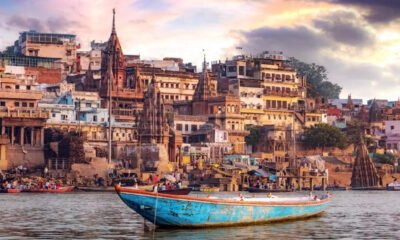Travel Guides & Articles
Pilgrimage tourism boom: MakeMy report shows 19% growth in FY24-25; surge in premium stays

MUMBAI: Group travel, short stays and last-minute bookings, these are the trends that define the popular religious tourism segment with pilgrimage travel emerging as one of the fast-growing segments of India’s travel and tourism industry. “Accommodation bookings across 56 pilgrimage destinations grew by 19% in FY24-25,” according to online travel company MakeMyTrip (MMT) which tracked for pilgrimage travel in 2024-2025. “The pilgrimage travel trends highlight broad-based momentum, with 34 destinations recording double-digit growth and 15 destinations growing by over 25%, underscoring how spiritual journeys are becoming a powerful driver of travel demand,” the MMT report said.The breadth of growth across pilgrimage destinations can be seen in centres such as Prayagraj (Uttar Pradesh), Varanasi (Uttar Pradesh), Ayodhya (Uttar Pradesh), Puri (Odisha), Amritsar (Punjab) and Tirupati (Andhra Pradesh), which continue to grow. At the same time, places like Khatushyam Ji (Rajasthan), Omkareshwar (Madhya Pradesh) and Thiruchendur (Tamil Nadu) are also registering strong momentum, reflecting the widening canvas of spiritual travel in the country.“The strong growth in pilgrimage demand is also driving an aggressive expansion of accommodation supply across key destinations. Travellers are largely opting for short, purpose-driven stays, with more than half choosing single-night trips. At the same time, premiumisation is gaining momentum, bookings for rooms priced above ₹7,000 grew by over 20%” it saidRajesh Magow, Co-Founder and Group CEO, MakeMyTrip, said, “Pilgrimage Travel has always been part of our culture, but what we see now is its scale and consistency across the country. We are seeing steady growth, fuelled by stronger connectivity and Indians across all age groups and income segments planning pilgrimage-led trips. This growing demand is broadening traveller expectations and prompting the industry to innovate in ways that better serve the unique needs of the pilgrim traveller.”
Nearly 2 in 3 pilgrimage bookings made within a week of travel:
The late booking trend is characteristic of Indian travellers, cutting across all segments of travel. Pilgrimage travel, much like leisure, continues to be booked very close to the date of travel, with more than 63% of bookings made within six days of departure.
Pilgrimage travel characterized by short, purpose-led stays:
Pilgrimage travel remains defined by short, purpose-driven stays. More than half of all travellers (53%) opt for single-night visits, compared to 45% in leisure travel. Two-night stays make up nearly one-third (31%) of trips, while three-night stays account for just 11%. Longer durations of four nights or more together contribute less than 5% of bookings, in contrast to leisure travel, which shows a more even spread across multiple nights.
Group travel distinctly stronger in pilgrimage:
Group bookings form a much larger share of pilgrimage travel, with 47% of trips made in groups compared to 38.9% in leisure destinations. This underlines the collective character of pilgrimage journeys, where families, friends, and community groups often travel together, further reinforcing pilgrimage as a deeply shared experience.
High-value bookings in pilgrimage cities outpace leisure destinations:
While most pilgrimage accommodation bookings (71%) are for rooms priced below ₹4,500 per night, premiumisation is gaining clear momentum. In FY24-25, bookings for rooms in the ₹7,000–10,000 range grew by 24%, while those above ₹10,000 grew by 23%. In parallel, alternate accommodation options such as homestays and apartments have also gained traction, contributing nearly 10% of room night bookings in pilgrimage destinations.
Pilgrimage Travel Spurs Wave of New Hotels and Homestays:
Over the past three years, pilgrimage destinations have seen a sharp rise in accommodation supply. More than a third of all hotel rooms available today at these locations were launched during the past three years, with even faster growth in homestays, apartments, and hostels. The expansion of homestays reflects both new additions and existing properties coming online as hosts tap into rising demand. Premium supply has also scaled rapidly, 63% of the premium accommodation available today were launched during the same period, reflecting how businesses are actively investing to capture the demand in premium segment.
Travellers increasingly combine pilgrimage with leisure experiences:
In FY 2024-25, over half (52%) of all holiday package bookings on MakeMyTrip were made by travellers seeking pilgrimage-led destinations only. At the same time, nearly 48% of bookings were from travellers who sought a combination of pilgrimage as well as leisure destinations within the same holiday package. Taken together, these trends point to a shift, with increasing number of travellers blending spiritual journeys and leisure pursuits to create a more wholesome experience.
Travel Guides & Articles
Air India adopts SITA tools for sustainability

With rising fuel prices and increasing global pressure to reduce carbon emissions, airlines are under constant demand to improve efficiency. Air India Group is taking proactive measures by adopting SITA OptiFlight and SITA eWAS, two cutting-edge digital solutions designed to optimise flight operations. This marks a significant milestone in the airline’s ongoing modernisation journey.
The rollout covers Air India’s Airbus A320 and Air India Express Boeing 737 fleets, operating across both domestic and international routes. Deployment for the widebody fleet is also planned in the near future. By leveraging these technologies, Air India expects to cut carbon emissions by nearly 35,000 tons annually, contributing directly to its sustainability goals.
SITA OptiFlight is a suite of intelligence tools that optimise critical phases of flight. At its center is OptiClimb, a climb optimisation solution that uses historical flight data, aircraft-specific models, and weather forecasts to generate tailored climb profiles. This enables pilots to cut fuel consumption during the most energy-intensive stage of flight while maintaining performance and safety.
SITA eWAS complements this by providing pilots with real-time weather updates and predictive forecasting. Equipped with this tool, crews can avoid turbulence, re-route more effectively, and make smarter in-flight decisions. Together, these systems empower pilots with actionable data that improves efficiency while supporting Air India’s environmental commitments.
Industry experts highlight this move as a strong example of how airlines can balance regulatory pressures with operational needs. Sumesh Patel, President, Asia Pacific at SITA, stated that predictive solutions like OptiFlight® and eWAS demonstrate how digital innovation can cut emissions, save fuel, and unlock real operational value.
Echoing this sentiment, Basil Kwauk, Chief Operations Officer at Air India, emphasised that sustainability and efficiency remain at the core of the airline’s transformation into a world-class carrier. By integrating advanced tools into daily operations, Air India is not only reducing its carbon footprint but also aligning itself with the global drive towards greener aviation.
Travel Guides & Articles
Indian Railways expands connectivity across Northeast’s hilly terrains

Indian Railways is accelerating efforts to expand rail connectivity across the Northeast, with new projects underway in Mizoram, Manipur, and Nagaland. Officials confirmed that surveys and construction are progressing in hilly terrains, aiming to bridge gaps between the region and the rest of India. Work is also in progress to extend railway access to Sikkim, with a new line expected to be completed soon.
According to South Central Railway Chief Public Relations Officer A. Sridhar, projects to connect the capital cities of Manipur and Nagaland are a top priority. These initiatives are expected to be completed within the next four years. Officials believe the new lines will bring significant social and economic benefits to the tribal populations of the Northeast.
The recently completed Bairabi–Sairang railway line in Mizoram highlights the scale of the effort. Passing through 48 tunnels, 87 minor bridges, 65 major bridges, and six road underpasses, the route links several villages, including Mualkhang, Kawapui, and Hotaki. Thousands of residents are expected to benefit from improved access.
Local voices reflect the impact of this development. “A journey from Bairabi to Sairang is a wonderful experience,” said Wesley, a youth who travelled on the test run. Others highlighted how decades of poor road and rail connectivity left towns like Aizawl and nearby areas cut off from the mainland.
The new Sairang railway station, located about 20 kilometers from Aizawl, is being seen as a game-changer for Mizoram. Residents believe it will boost economic opportunities, improve tourism, and provide easier access to healthcare and education. Many expressed gratitude for the government’s renewed focus on the Northeast.
Officials from Northeast Frontier Railway emphasised that these projects are part of a larger vision to integrate the region with the national network. With sustained investments in infrastructure, the Northeast is poised to move closer to the mainstream, supporting both regional growth and national connectivity.
Travel Guides & Articles
Valley of Flowers India & Other Places Famous For Flowers – Travel and Leisure Asia

Valley of Flowers India & Other Places Famous For Flowers Travel and Leisure Asia
Source link
-

 Business2 weeks ago
Business2 weeks agoThe Guardian view on Trump and the Fed: independence is no substitute for accountability | Editorial
-
Tools & Platforms1 month ago
Building Trust in Military AI Starts with Opening the Black Box – War on the Rocks
-

 Ethics & Policy2 months ago
Ethics & Policy2 months agoSDAIA Supports Saudi Arabia’s Leadership in Shaping Global AI Ethics, Policy, and Research – وكالة الأنباء السعودية
-

 Events & Conferences4 months ago
Events & Conferences4 months agoJourney to 1000 models: Scaling Instagram’s recommendation system
-

 Jobs & Careers3 months ago
Jobs & Careers3 months agoMumbai-based Perplexity Alternative Has 60k+ Users Without Funding
-

 Podcasts & Talks2 months ago
Podcasts & Talks2 months agoHappy 4th of July! 🎆 Made with Veo 3 in Gemini
-

 Education2 months ago
Education2 months agoVEX Robotics launches AI-powered classroom robotics system
-

 Education2 months ago
Education2 months agoMacron says UK and France have duty to tackle illegal migration ‘with humanity, solidarity and firmness’ – UK politics live | Politics
-

 Podcasts & Talks2 months ago
Podcasts & Talks2 months agoOpenAI 🤝 @teamganassi
-

 Funding & Business3 months ago
Funding & Business3 months agoKayak and Expedia race to build AI travel agents that turn social posts into itineraries





